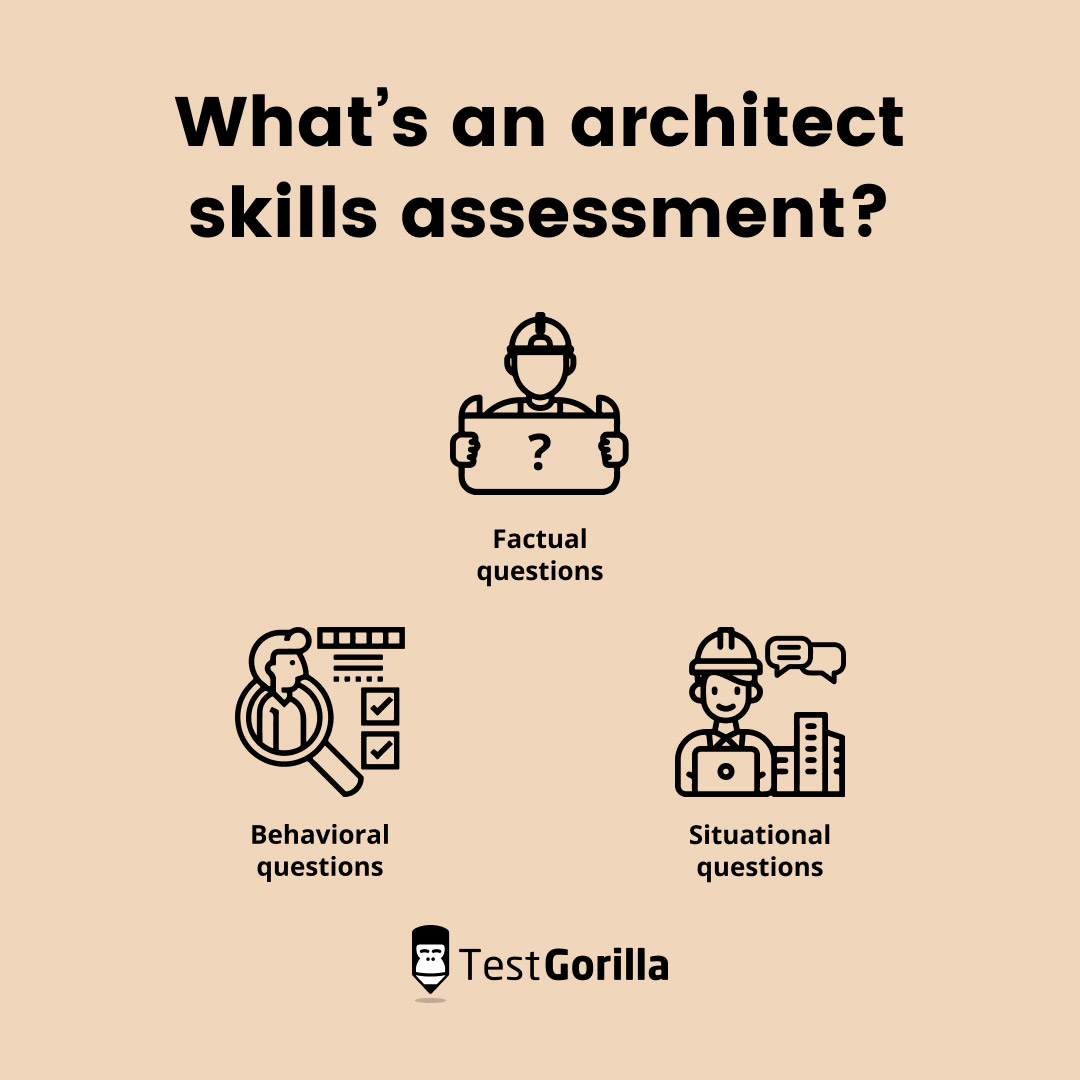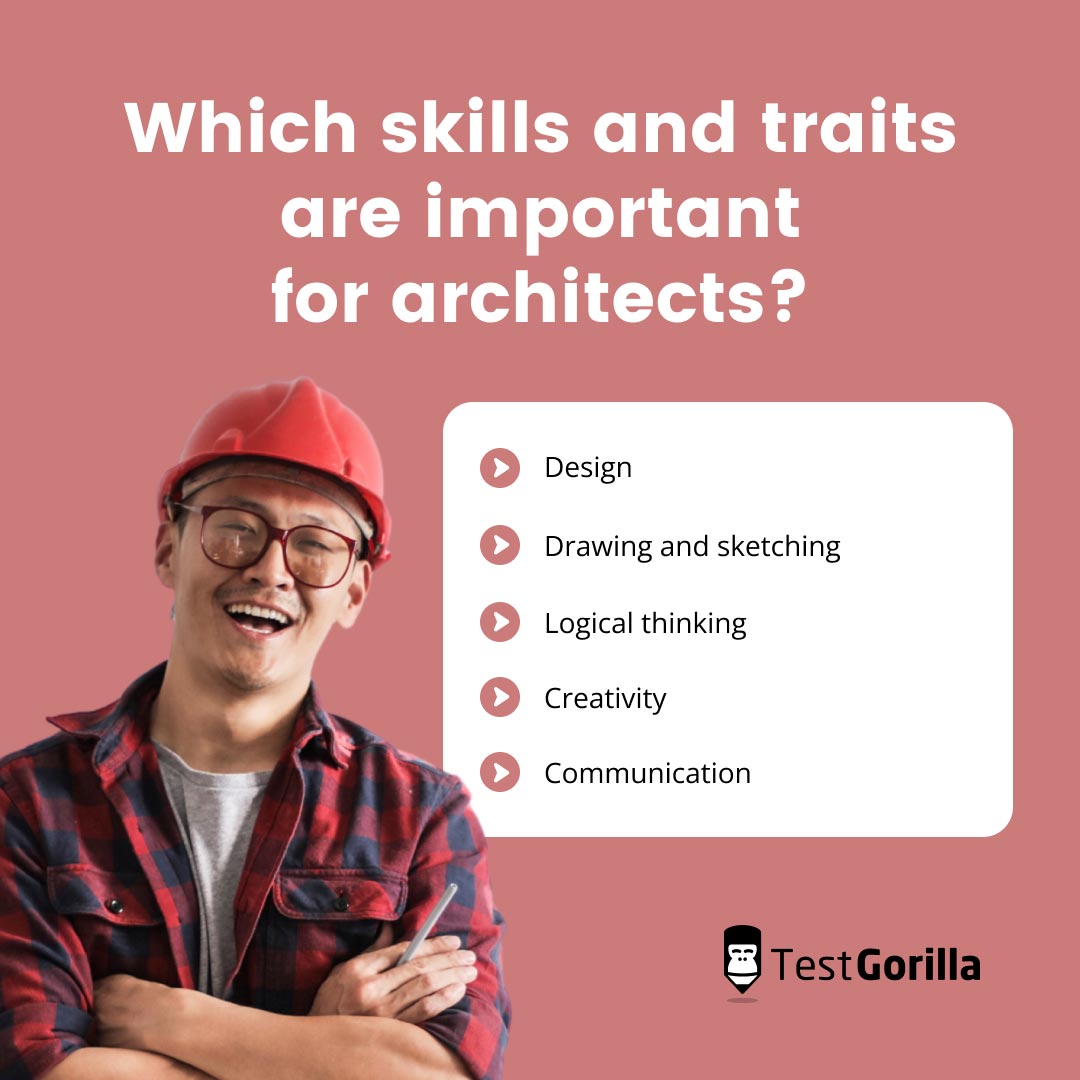Are you hiring an architect for your firm?
Taking a skills-based approach to recruitment can help. A strong skill set lets architects successfully design residential and commercial buildings like houses, educational facilities, and factories. Hiring someone with relevant skills like precision, creativity, and logical thinking ensures they deliver successful project outcomes.
Talent assessments measure a candidate’s relevant skills and traits, giving you a more in-depth view of their ability to manage technical architectural tasks than traditional hiring practices. Seeing their skills in action will give you confidence in selecting a candidate whose abilities align with your specific position.
So, how does skills and traits testing work?
Read on as we uncover which architect skills are the most valuable to look for in candidates and share skill-specific tests that you can include in your assessment to target these top skills.
Table of contents
- What’s an architect skills assessment?
- Why are architectural skills important?
- Which skills and traits are important for architects?
- Skills and traits tests
- Architect skills assessment FAQs
- How TestGorilla can help you find skilled architects
- Optimize your recruitment process with TestGorilla’s assessments
What’s an architect skills assessment?
An architect skills assessment lets you easily and efficiently screen candidates and shortlist those who demonstrate competency in specific areas relevant to the role. Although a candidate may outline their skill set on their resume, it’s difficult to predict how they’d apply these skills in specific situations on the job.
Skills testing combines factual, behavioral, and situational questions to deliver a well-rounded view of each candidate’s competencies.
Here’s an outline of the various question types and why they are each beneficial to assessing architectural skills:
Factual questions have a right and wrong answer. For example, if you’re looking for architects who need digital drawing skills, our AutoCAD test asks questions about the purpose of certain program features. Candidates who answer correctly display greater knowledge in applying skills relevant to this area.
Behavioral questions help you assess how people react to challenges, like receiving negative client feedback or facing non-negotiable deadlines, and how they apply solutions. For instance, our Problem solving test delves into how candidates manage their schedules and make key decisions.
Situational questions assess how candidates respond to social situations and communicate with others. Our Communication test, for example, evaluates how candidates interpret written information and share valuable insights. Good communication ability lets candidates relay specific architectural concepts to others in an understandable manner.
Why are architectural skills important?
Architectural jobs involve highly technical tasks like drawing blueprints, taking measurements, and using complex modeling software to convey ideas visually.
Employing someone with skills at the required level ensures they can complete these tasks to a high standard. Here are three benefits of hiring someone with adequate architectural skills:
1. Increased clarity over designs
Architects transfer initial ideas on how structures will look and function into sketches and diagrams. Precise planning is paramount to a project’s success because other contractors rely on these drawings to bring the concept to life.
For example, construction workers, plumbers, and electricians use blueprints to evaluate the size of rooms, materials required, and placement of facilities, like lighting fixtures and electrical outlets. Equally, sufficient planning ensures the building is functional, durable, and safe.
In this scenario, hiring someone with accuracy and meticulous architectural drawing skills means they will clearly present volumes, heights, points, doors, and lines on blueprints. These details ensure contractors meet necessities, like the height and width of walls.
Clarity over the project’s components can prevent delays, minimizing wasted time, finances, and other resources.
2. Greater project success
Hiring a skilled architect is important because clients and stakeholders rely on their expertise to execute their preferences and specifications effectively. Candidates with strong design skills are more likely to propose relevant and cutting-edge ideas. They’ll have a better grasp of how to develop unique concepts without compromising on functionality.
As a result, people involved in the project may feel more confident in your hire’s service and perceive your new hire as an effective resource.
If your company works with external clients pleased with the project’s outcome, customers are more likely to spread positive word-of-mouth, a highly valuable form of organic marketing. In fact, the University of Florida reports that personal recommendations can increase sales by up to 11%.
Alternatively, a talented in-house architect can streamline project progression and foster better connections with stakeholders and project managers.
3. Compliance with safety and functionality
Someone with good architectural skills can apply their knowledge of the legal landscape to maintain compliance and safety within visually appealing designs.
Compliance is vital to the sustainability of your business, as infringing on local, state, and national laws can have severe implications, such as fines and criminal investigations.
Hiring an individual with strong architectural abilities enables you to put trust in their work, allowing them to work more independently. Fostering a team that works well autonomously can elevate productivity because you spend less time doubling up on tasks or rectifying errors.
The best insights on HR and recruitment, delivered to your inbox.
Biweekly updates. No spam. Unsubscribe any time.
Which skills and traits are important for architects?
Architects require hard skills to perform job-specific tasks confidently. Given the role’s technicality, candidates rely on soft skills to rationalize complex tasks and provide meticulous service.
Review the following list that breaks down the abilities associated with the architecture skill set so you can identify which competencies you want to test in your assessment:
Design
Design is arguably the most important skill for architects because this ability determines a structure’s format, layout, purpose, and appearance. Try to identify candidates with personal style and the ability to interpret specifications to tailor designs.
Authenticity benefits both clients and the company – clients who find artistic concepts challenging to visualize can take inspiration and guidance from your hire. Meanwhile, having a distinctive style is good for brand awareness.
If your role involves using digital drawing software to construct 2D and 3D models, ensure your talent assessment covers software proficiency. These applications have complex controls, so you should evaluate whether you’d prefer a candidate who can use drawing and editing features effectively.
Drawing and sketching
Architects rely on visual aids to communicate ideas and help clients and contractors envision how a project will look at various stages. There are several types of architectural drawings and diagrams. These include the following:
Floor plans
Site plans
Landscape drawings
Design depictions
Final product drawings
Blueprints
Consider hiring someone with strong technical drawing skills to ensure they can capture the dimensions, textures, and finer details in these plans. Clear imagery enhances the understanding of various parties involved in a project, such as stakeholders or clients.
Logical thinking
Although creative architectural professionals add value by developing unique concepts, you’ll also want someone who can think logically.
Striking this balance means they understand how to regulate their creativity, so they make decisions that align with the brief rather than their own personal taste. This skill is paramount to successful project execution, ensuring all parties remain happy with the project’s development.
Logical thinking means prospective hires can rationalize complex tasks, like drawing initial floor plans or landscape drawings for a new project.
It also supports mathematical thinking. Mathematical proficiency is valuable because it ensures new hires can take accurate measurements, calculate probability, and estimate costs compared to budgets.
Logical thinking also helps prospective employees consider and comply with building and privacy regulations or follow company policies while designing.
For instance, a building architect might develop a highly intricate, visually appealing design that’s impractical and imposes health and safety regulations. Employing someone who can set realistic expectations will save considerable time, streamlining project progress.
Creativity
Creativity empowers architectural hires to make the most of the space and tools they have. It helps them think innovatively, helping your company to foster a competitive advantage over others.
Hiring a creative individual enables you to trust them to share new ideas and discuss efficient ways to overcome collective challenges. Equally, a building architect should propose ways to incorporate storage, heating facilities, ventilation, and furniture in small rooms.
Employing creative individuals is a valuable way to sustain a culture of innovation, helping others on the team feel motivated. Inspired teams are more likely to stay in their positions. Employee retention benefits your company because you can nurture talent who already understands your business goals and values.
Communication
Strong communication skills enable your new hire to be effective in sharing regular updates and relaying important information to maintain transparency. Meanwhile, active listening enables individuals to extract key points and ask productive follow-up questions.
These qualities are particularly beneficial to customer-facing positions. Active listening helps architects identify specific details about clients’ and stakeholders’ visual preferences and ideal outcomes to provide a positive experience.
Communication also involves adaptability. Hiring someone who observes conversational cues can keep discussions on topic and adjust their tone of voice to meet the other party’s expectations.
Skills and traits tests
At TestGorilla, we have a broad range of expert-created skills tests to help you find the perfect architect for your unique vacancy. You can preview the questions for various tests before including them in your talent assessment to ensure they’re appropriate for the job. Here are some examples of tests you might include in your architect skills assessment:
AutoCAD test
AutoCAD is a digital software that enables architects to design and produce technical drawings of floor plans and create 2D and 3D visualizations of structures. Include the AutoCAD test in your recruitment process if you want to find someone confident using this complex tool.
This test will assess candidates’ drawing techniques, helping you evaluate whether their competency meets your job’s specifications.
Attention to detail (visual) test
Architects of all disciplines work with visual aids to propose development plans and define the end goal, whether for a new computer network or a commercial apartment complex.
Using our Attention to detail (visual) test gives you confidence in candidates’ ability to interpret visual concepts, recognize trends, and identify slight details or differences. Employing candidates who excel in these areas ensures designs remain consistent and free of human errors.
Suppose you’re hiring a computer systems architect. In this case, you may also include the Attention to detail (textual) test in your assessment because people in this role rely on accurate coding skills to construct and perform as intended.
Similarly, solutions architects convey strategies using written texts that cross-departmental teams will receive. Ensuring they can spot grammatical errors prevents misunderstandings.
Communication skills test
Hiring someone with strong communication skills ensures your clients remain updated on progress and have consistent opportunities to share their opinions and ask questions. It also fosters a positive workplace culture where relationships are open and honest.
You can pre-screen candidates with the Communication skills test to review their written and verbal communication and can compare it to your team’s current communicative style. The results will outline candidates’ abilities to maintain professionalism, write clear and concise messages, and interpret written text.
Consider using the Communication (intermediate) test if you’re looking for someone to take on a more senior or influential role, such as a department lead. This test homes in on interpersonal communication and candidates’ ability to liaise with other business professionals, which is ideal if they’ll share designs with stakeholders.
Architect skills assessment FAQs
By now, you better understand the several characteristics and hard skills that make up the architectural skill set, but are you looking for more information about skills testing and TestGorilla’s talent assessments? Review the answers to frequently asked questions below:
What does an architecture assessment include?
Architecture assessments should contain various situational, cognitive, and factual questions and cover an appropriate mix of traits and topics. You can include five tests in your TestGorilla talent assessment. Consider including tests that target visual awareness, such as our Attention to detail (visual) test, or involve designs and calculations, including imagery to examine candidates’ critical thinking and observation skills.
How do you perform an architecture assessment?
First, identify your position’s core requirements and select the relevant skills- or job-specific tests from TestGorilla’s library. Include up to 20 custom questions to customize your assessment and best gauge your candidate’s personality.
Next, invite applicants to participate in testing via email or your applicant tracking system. Finally, review the results and compare your candidate pool in our system to easily identify top talent.
Is architecture a hard skill?
Architecture is a skill set that incorporates design, drawing, patience, logical thinking, mathematics, computer literacy, and spatial awareness. Candidates with architectural skills can identify how various components connect to create a structure or strategy, such as a building, cloud computing network, software, or solution. It applies to multiple jobs because it facilitates the ability to construct something functional, original, and safe.
How TestGorilla can help you find skilled architects
Designed, tried, and tested by experts, TestGorilla’s skills and traits assessments provide a fair and effective way to identify the perfect candidate for your open position.
You can yield the following benefits when you use skills-based hiring:
Shorten your recruitment process. Tailoring your talent assessment to test for the particular traits and skills candidates need to perform the job to a high standard will minimize your time searching for competent candidates.
Get results you can rely on. Our reliable tests are backed and optimized by science, meaning you can trust the results you receive. All applicants will receive the same test, meaning all candidates have been given an equal opportunity to display their strengths.
Ensure a user-friendly interface. For TestGorilla, fostering a positive user experience is a priority. Candidates can easily navigate our assessments without site-based disruption, meaning their results give you a more genuine depiction of their abilities. Similarly, you’ll find results comparison and advice easy to access, supporting you in the decision-making process.
Find out for yourself with our free demo.
Optimize your recruitment process with TestGorilla’s assessments
Architecture involves a highly methodical approach in which a candidate must display high levels of mechanical and logical technicality.
Skills in this discipline often take people years to develop, so we understand that hiring someone already equipped with relevant capabilities is key to your company’s success.
So, where do you go from here?
We’ve worked with experts to design several tests focusing on some of the most essential architectural skills or roles, helping you find the right person for the job.
Register for our free plan to get acquainted with our innovative features. You’ll receive 10 free tests and all the personality tests that allow you to find a cultural fit for your firm, too.
You've scrolled this far
Why not try TestGorilla for free, and see what happens when you put skills first.




















